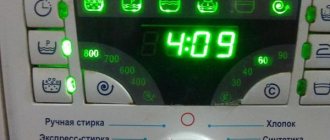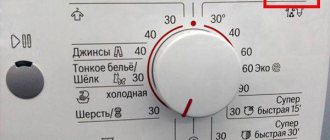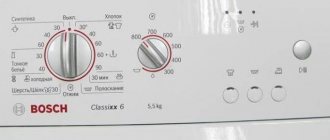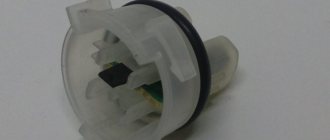Often during operation a problem arises when the washing machine does not heat the water or does not heat it enough. If such a malfunction occurs, most modern models with an automatic self-diagnosis system stop working and display a fault code on the display. Simpler units usually continue the washing process in cold water, which can make it difficult to detect this breakdown in a timely manner.
The first obvious sign of insufficient or complete absence of heating during the washing process is poorly washed laundry. You can check and fix this malfunction yourself or with the assistance of a repairman from the service center.
Why does the washing machine wash in cold water?
Possible malfunctions in which the machine washes in cold water According to the experience of RemBytTech specialists, most often the lack of heating of water is associated with a breakdown of the heating element. Due to impurities in tap water, detergent residue and lint from clothes, the heating element becomes coated with scale and burns out.
Interesting materials:
How to create a new page on the site? How to create a new row in Excel? How to create a new tab in Google? How to create an object in Sketchup? How to create your own GIF in Viber? How to create your own media library on iPhone? How to create a text file in Android? How to create Twitch Prime for WOT? How to create a closed session in GTA Online 2022? How do I create a Steam support ticket?
Fault detection methods
There are several ways to test an automatic washing machine for the functionality of the heating element. The simplest and most informative diagnostic option is carried out in the following sequence:
- Place a small amount of cotton laundry in the drum.
- Select the automatic washing mode, in which the temperature of the liquid inside the machine should be at least 60˚C.
- Press the “Start” button.
- After the household appliance has been operating for about 20 minutes, place your palm on the glass part of the loading hatch.
If you feel warmth when touched, this indicates that the washing machine has heated the water inside the drum.
Some models of washing machines, Bosch and Zanussi have a large number of washing programs. Therefore, if for some reason it was not possible to determine in time the heating of the liquid in the manner described above, and the draining of the liquid has already begun, then it is enough to touch the drain hose to determine the temperature of the water removed from the washing machine.
To finally make sure that the machine is heating water, you should pay attention to the electric meter. The heating element of a washing machine can consume 2 or more kilowatts of electricity per hour, so its inclusion in operation will be indicated by the frequent blinking of the control LED and the movement of numbers in the far right row of the meter.
In order to avoid getting false results during this experiment, it is recommended to turn off all devices that consume electric current, including the refrigerator and lighting elements that use incandescent lamps.
If during the experiments it was possible to determine the performance of the electric heating element, then you can continue to operate the washing machine as usual. Otherwise, you will need to find out why the liquid is not heating.
Heating element test
First, disconnect the washing machine from the power supply and turn off the water tap. Next, we provide free access to the heater and, if necessary, remove the back wall or bottom. Next, take a multimeter and start testing.
- We photograph the heating element to record the connected wiring and eliminate errors during future installation.
- Disconnect all connected wires.
- We set up the multimeter to measure resistance and set the selector to 200 Ohms.
- We attach the probes to the contacts.
- Let's evaluate the result.
A working heater always shows a fixed value of 26.8 ohms. Slight deviations from the norm within +-5 are possible. If one is displayed on the screen, then a line break has occurred inside the heating element and a part change is necessary. When the tester showed “0” or another number less than 1, a short circuit was detected and the element burned out.
Voltage drops in the electrical network and hard water with an abundance of impurities lead to problems with the heater.
Often, checking for resistance is not enough, since if the external condition is good, the dielectric inside can leak into the housing and cause a current leak. To ensure safe operation of the machine, it is recommended to check the heating element for breakdown. It is enough to turn the tester into buzzer mode, attach one probe to the contact, and attach the second to the body of the multimeter. If there is no piercing squeak, everything is fine. Otherwise, it is necessary to urgently change the part and not use the machine until the repair is completed.
Why can’t heating up the machine be completely avoided?
No matter how elegant and precise your machine is, don’t forget that it has an electric motor inside. And, if you have a good car, this motor is quite powerful. For example, Mustang clippers produce 5,900 rpm. That is approximately 98 revolutions per second! Yes, yes, this is the very time you need to say “one”.
The knives move at incredible speed. Naturally, they heat up - even with good lubrication, the friction force still remains. And the engine itself, which produces such power, gets hot. This cannot be avoided except by turning off the machine.
But. This does not mean that the machine in your hands has the right to turn into a switched-on iron. The design of the machine must be such that the generated heat is distributed and does not cause discomfort during operation. And if the machine starts to heat up indecently, it means that either the design was not reasonable enough from the start, or something happened to the machine.
Source
Tips and tricks
- To determine the heating of water in devices with vertical loading, it is enough to touch the side surface of the device while the device is operating. To detect a breakdown, in this case, you can also record the counter readings before turning on the washing machine and after the end of the washing cycle. The changes must be at least 0.5 kW. The temperature of the drain hose can also be used to determine the presence or absence of heating in household appliances of this type.
- If, as a result of “thermal” tests, it was not possible to detect signs of heating and you decide to independently remove the internal elements for inspection, then you should definitely turn off the power to the washing machine and turn off the water supply.
- In order not to miss the moment when the washing machine heats the liquid, it is recommended to touch the glass part of the door several times during washing. It should also be borne in mind that if the washing process is completed and the rinsing procedure has begun, then, in many cases, the glass and hose of the household appliance will be cold.
- The performance of the heating element can be determined using a multimeter. A working device will show a resistance of several tens of ohms. You can read about how to find out if the heater is working properly in specialized literature, but the simplest test is using a light bulb and a twelve-volt battery. If you pass an electric current through a heating element, the lamp connected to it will light up.
- If the heating element is fully operational, but there is a significant layer of scale on its surface, then to restore the functionality of the device you will need to completely clean the metal of calcium deposits.
How to determine whether a washing machine is heating water or not is no longer a secret. In most cases, the diagnostic methods listed above allow you to accurately determine the performance of the heating element.
Wrong washing program selected
Sometimes, due to simple inattention, a washing mode may be selected that does not involve heating the water (delicate wash, etc.). Some washing machine models allow you to select the water temperature in the machine and the washing method by turning various switches or knobs. So, for example, even by choosing a washing temperature of 95 degrees, you can accidentally select a mode that provides washing at a temperature of about 40 degrees. Since the washing program has priority over the temperature regime, accordingly, the temperature of the water in the tank will not exceed 40 degrees.
To prevent this situation from happening again, you need to carefully read the instructions for the washing machine and select the washing mode and temperature accordingly.
Only the capacitor is hot
Users often notice that it is not the engine itself that overheats, but the capacitors provided in it. The main reason for this is the discrepancy between the capacity of the device and the power of the motor.
If the starting device overheats, purchase a new capacitor MBGO or MBGCH of appropriate capacity.
These types of capacitors are designed to operate on alternating voltage. They are distinguished by better cooling. When purchasing a starter, be sure to focus on the model and characteristics of the electric motor of your washing machine. Instead of one new capacitor of larger capacity, it is possible to add an additional device to the existing one. The devices are connected to the working and starting windings in parallel.
Source
Only the rotor is hot
The rotating element of an electric motor is called a rotor. It is connected directly to the drive shaft. Rotary mechanisms vary in design and parameters, and differ depending on the engine model.
The engine rotor also tends to heat up. Typical reasons for this:
- discrepancy between the rotor power and the specific electric motor;
- breakage of the rotor winding;
- unsuitable capacitor;
- improper heat dissipation (the impeller ceases to perform its functions fully);
- bearing damage. The main symptom of such a breakdown is the rotor shaft not turning by hand. To fix the problem, replace the elements;
- poor contact or breakage of a short-circuited squirrel cage type winding;
- motor shaft wedge. In most cases, with such a problem, the machine is knocked out or the fuse is blown.
To prevent the rotor from overheating, do not subject the engine to increased loads, follow the operating rules and the established temperature conditions.
You can test the rotor winding with a multimeter. If the readings on the device screen are too high, the electric motor will need to be repaired.
Heating element test
First, disconnect the washing machine from the power supply and turn off the water tap. Next, we provide free access to the heater and, if necessary, remove the back wall or bottom. Next, take a multimeter and start testing.
- We photograph the heating element to record the connected wiring and eliminate errors during future installation.
- Disconnect all connected wires.
- We set up the multimeter to measure resistance and set the selector to 200 Ohms.
- We attach the probes to the contacts.
- Let's evaluate the result.
Control module failure
In some cases, the water does not heat up due to the fact that the corresponding commands are not received from the control module. The reasons for the failure of the programmer can be different - a failure in the firmware, failure of triacs, relays or tracks connected to the heating element. Microcracks on the tracks can also lead to malfunctions. Depending on the cause of the malfunction, the control module needs to be repaired or replaced. It is advisable not to try to repair the control module yourself, but to entrust it to professionals.
Part Search
If you have doubts about the performance of the heating element, you will have to “ring” it with a multimeter. First you need to find the device itself in the machine. Its location largely depends on the manufacturer’s brand, for example, in Indesit and Ariston it is located at the back, in models from Bosch and Siemens it is at the front.
Having in hand the factory wiring diagram for the heating element in the washing machine, you can speed up the search.
If there are no instructions, then we look for the heater ourselves:
- We examine the back wall of the machine. Often a large panel indicates a heating element located behind it;
- put the body on its side or tilt it back to look into the bottom and try to detect the heating element near the washing tub;
- remove the back cover and carefully inspect the space around the tank;
- We take a flashlight, shine a light through the inside of the drum and try to determine by eye the location of the heater.
The task is simplified by the fact that the heating element is always in the washing tub. It is only necessary to specify its location. There is no need to remove the device - you can “ring” the heater without removing it. We’ll tell you how exactly later.
Lawn mower motor gets hot
Many lawn mowers have an electric motor, which in certain situations can overheat and then shut down.
The reasons may be as follows:
- interturn short circuit in the winding;
- problems with the starting capacitor (capacitance mismatch, failure);
- long-term operation (above the recommended parameter);
- misalignment of the flanges during assembly, which creates an increased load on the bearings;
- incorrect connection (for example, the main and starting windings are mixed up);
- wear and damage to brushes/bearings;
- problems with supply voltage.
Judging by reviews on the Internet, common causes of overheating of a lawn mower's electric motor are interturn short circuits and operation of the device beyond the specified time.
Prevention of breakdowns
- To avoid this problem, you should take simple measures in advance, without waiting until the washing machine stops heating the water.
- Carefully study the instructions before operating the washing machine;
- Add water softeners to the washing liquid. This will allow you to face the scale problem later;
- Also, to combat scale, regularly run it at idle speed with special means that help clean the machine from deposits;
- If possible, clean the water level sensor tube without waiting until the washing machine stops heating the water.
If you follow these simple rules, then the trouble in question may not happen.
- Is it possible to wash a blanket in a washing machine?
- How to wash a sweater so that it shrinks
How to determine if the engine is overheated
At first glance it seems very simple - according to the indicators of the engine temperature device, or - sensor. This is true, if not for one thing - novice motorists are so captivated by the road situation around them that they look at the instrument panel only in one case - how much fuel is left. Experienced motorists, on the contrary, due to their confidence in their abilities, also do not look at the car’s dashboard. And as a result, a situation often arises that overheating is detected when the engine temperature has long exceeded permissible limits, and irreparable damage has been caused to the engine. It is irreparable overheating that is one of the most complex malfunctions, which leads to very serious consequences. But more on that later. But there is a way that will not let you miss the moment of overheating. This is problematic in a traffic jam, and is not always clearly present, but here’s what you should be aware of:
As soon as the engine temperature exceeds the permissible norm, when you sharply press the gas pedal, or when accelerating the car, even slightly, detonation knocks can be clearly heard
, which are popularly called “tapping fingers.” This is not true, but everyone knows this definition. If you hear such a sound, there is a 99% chance that the engine has overheated, and action must be taken.
Detonation knock is a loud metallic knock, the frequency of which coincides with the engine speed. You've probably heard such sounds when refueling with low-quality fuel. I personally don’t know where the concept of “tapping fingers” came from. But the real reason for such knocking noises is a disruption in the fuel combustion process. What you hear is nothing more than explosions of the fuel mixture. During normal engine operation, the combustion process is controlled, but as soon as one of the operating parameters is violated, the process goes out of control and combustion turns into an explosion. Hence the concept - detonation (from the word detonate - explode) knocks. When the engine overheats, this is the first sign.
Before continuing the conversation, let's define what is normal temperature and what is overheating. There is no one-word answer, but there are general rules. The engine temperature is within 85-95 degrees Celsius, which is working. Engine temperature up to 100 degrees is acceptable. This means that a short-term increase in temperature to 100, sometimes up to 105 degrees is allowed. Just for a short time - up to 5 minutes. Engine temperature above 105 degrees Celsius means overheating and action must be taken.











